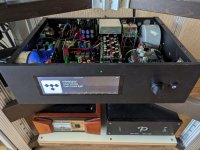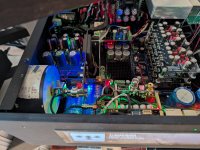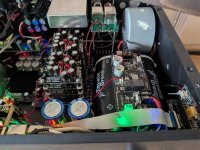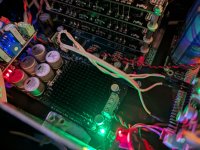Hi everyone,
I'm looking to build a high-quality streamer and DAC using Ian Canada components, the ESS 9039Pro chip, and a Raspberry Pi 5 as the base. The system should have a pre-installed operating system like Volumio or Daphile, and it must feature a coaxial output independent of the DAC. Does anyone know if there is a detailed guide or step-by-step instructions available for this specific build? Any help or insights would be greatly appreciated!
Thanks in advance!
I'm looking to build a high-quality streamer and DAC using Ian Canada components, the ESS 9039Pro chip, and a Raspberry Pi 5 as the base. The system should have a pre-installed operating system like Volumio or Daphile, and it must feature a coaxial output independent of the DAC. Does anyone know if there is a detailed guide or step-by-step instructions available for this specific build? Any help or insights would be greatly appreciated!
Thanks in advance!
I would start with the Ian boards you're going to use. Download the user guide for each board. There are a couple videos on Youtube, but maybe not detailed enough. I've had many of my projects change design during the implementation process and I had to rethink what options I wanted to include. 🙂 With Ian's boards, you can start small and see how it goes, and then add more features in the future.
riccaficca
https://www.youtube.com/@Gabster1
He has a youtube channel that has tons of info. Step by step build videos. Have fun.@JMD3254 and @redjr
Thank you both so much for your replies! I really appreciate the guidance.
I'm completely new to the DIY world and would love to build something without needing to do any soldering—unless it's absolutely necessary for achieving superior sound quality.
Alternatively, is there any way to purchase a preassembled streamer and /or DAC using Ian Canada components? Ideally, I’d love something based on a Raspberry Pi 5 and an ESS 9039Pro DAC.
Thanks in advance for any advice! 😊
Thank you both so much for your replies! I really appreciate the guidance.
I'm completely new to the DIY world and would love to build something without needing to do any soldering—unless it's absolutely necessary for achieving superior sound quality.
Alternatively, is there any way to purchase a preassembled streamer and /or DAC using Ian Canada components? Ideally, I’d love something based on a Raspberry Pi 5 and an ESS 9039Pro DAC.
Thanks in advance for any advice! 😊
You can start with a project here - https://iancanada.ca/products/flags...rk-music-streamer-kits?variant=47606889152812 . All components except power supply can be bought in one go. No soldering needed. Folks can then help you with what is needed for power supply. No soldering needed there either(i built one with no soldering). Then as you gain experience with soldering you can do more advanced stuff.I'm completely new to the DIY world and would love to build something without needing to do any soldering—unless it's absolutely necessary for achieving superior sound quality.
Dddac mk2 4 deck combined with ian Canada products plus an external clock. used a FifoPiQ7ll and transport pi mk2.
only a 3.3v shunt regulator needs to be added to the input Transport pi mk2.
also ordered better cables which I hope to receive tomorrow. sounds very nice.
There is also a simple toslink to spdif coax converter in it, maybe I will replace it with a receiver pi DDC ll.
only a 3.3v shunt regulator needs to be added to the input Transport pi mk2.
also ordered better cables which I hope to receive tomorrow. sounds very nice.
There is also a simple toslink to spdif coax converter in it, maybe I will replace it with a receiver pi DDC ll.
Attachments
Why not feeding the DDDAC with I2S? I think in your setup, by using the SPDIF input at DDDAC, the Tentclock on the DDDAC board is involved and will be the last instance which "reclocks" the digital signal!? I could imagine, that your nice clock / FifoPi combo in front of the DDDAC does not have a big impact then!??
that is exactly what you indicate there is a marginal difference in sound.
next step is i2s from the gpio or ufl connector I have also made a switch in between to be able to switch between transport pi mkll and i2s.
for that I still have to order an ian Canada dddac ufl adapter.
next step is i2s from the gpio or ufl connector I have also made a switch in between to be able to switch between transport pi mkll and i2s.
for that I still have to order an ian Canada dddac ufl adapter.
@michl2604 what are the dimensions of your enclosure for the dddac? And where did you source it from?
I have FifoPiMa connected directly to PRI4 (dtoverlay=hifiberry-dacplus)
When played and measured square 1khz at the DAC output, I noticed a ringing like this:

After that, I measured other i2s signals and noticed similar for BCLK(SCK)

Also tried without DAC connected measuring at GPIO18 (pulled down with 10k), but looks the same.
Am I doing something wrong or this is normal BCLK signal but dac out ringing coming from somewhere else?
Other i2s signals looks fine I think:
MCLK:

LRCK:

Data:

When played and measured square 1khz at the DAC output, I noticed a ringing like this:
After that, I measured other i2s signals and noticed similar for BCLK(SCK)
Also tried without DAC connected measuring at GPIO18 (pulled down with 10k), but looks the same.
Am I doing something wrong or this is normal BCLK signal but dac out ringing coming from somewhere else?
Other i2s signals looks fine I think:
MCLK:
LRCK:
Data:
in the meantime a direct i2s connection has been made. it sounds very different now. first listen like this for a while to get an idea of what sounds better now.Why not feeding the DDDAC with I2S? I think in your setup, by using the SPDIF input at DDDAC, the Tentclock on the DDDAC board is involved and will be the last instance which "reclocks" the digital signal!? I could imagine, that your nice clock / FifoPi combo in front of the DDDAC does not have a big impact then!??
Attachments
I think you mean the one from @gizmo3 !?@michl2604 what are the dimensions of your enclosure for the dddac? And where did you source it from?
Nice, I would be interested in your impression regarding the sound differencesin the meantime a direct i2s connection has been made. it sounds very different now. first listen like this for a while to get an idea of what sounds better now.
have you check your oscilloscope probes and terminated the dac output by connecting it to something, like a preamp, and i think your MCLK signal should be a square wave maybe the probes again, not an engineer so those are just my thoughts, and you oscilloscope should have at least a 30mhz bandwidthI have FifoPiMa connected directly to PRI4 (dtoverlay=hifiberry-dacplus)
When played and measured square 1khz at the DAC output, I noticed a ringing like this:
View attachment 1440594
After that, I measured other i2s signals and noticed similar for BCLK(SCK)
View attachment 1440595
Also tried without DAC connected measuring at GPIO18 (pulled down with 10k), but looks the same.
Am I doing something wrong or this is normal BCLK signal but dac out ringing coming from somewhere else?
Other i2s signals looks fine I think:
MCLK:
View attachment 1440604
LRCK:
View attachment 1440605
Data:
View attachment 1440606
i think you mean me.@michl2604 what are the dimensions of your enclosure for the dddac? And where did you source it from?
it is this case bought at audiophonics, only the front is aluminum the rest is a steel case.
https://www.audiophonics.fr/en/boitiers-19-3u/hifi-2000-case-3u-300mm-front-10mm-black-p-914.html
I'll let you know.Nice, I would be interested in your impression regarding the sound differences
Good day,I have FifoPiMa connected directly to PRI4 (dtoverlay=hifiberry-dacplus)
When played and measured square 1khz at the DAC output, I noticed a ringing like this:
View attachment 1440594
After that, I measured other i2s signals and noticed similar for BCLK(SCK)
View attachment 1440595
Also tried without DAC connected measuring at GPIO18 (pulled down with 10k), but looks the same.
Am I doing something wrong or this is normal BCLK signal but dac out ringing coming from somewhere else?
Other i2s signals looks fine I think:
MCLK:
View attachment 1440604
LRCK:
View attachment 1440605
Data:
View attachment 1440606
Square (pre and post ringing) at your DAC output is typical for OS DAC with digital filtering.
For better BCLK square try increasing the series resistance at BCLK at the output of the reclocker.
Hello all,
I am currently working on a USB DAC with PCM2707 and PCM1794 and they are connected via I2S.
I am looking at the data sheets and some designs online and I am curious about one thing... some designs include in-line resistors in the I2S signals between the chips. I tried looking as to why are people doing that and data sheets are omitting it.
I also noticed that there are in-line resistors on the USB lines at D+ and D- at 22ohms. I just put them there because that is what was show in the datasheet and other design but without really thinking about it.
So what are the reasons...
I am currently working on a USB DAC with PCM2707 and PCM1794 and they are connected via I2S.
I am looking at the data sheets and some designs online and I am curious about one thing... some designs include in-line resistors in the I2S signals between the chips. I tried looking as to why are people doing that and data sheets are omitting it.
I also noticed that there are in-line resistors on the USB lines at D+ and D- at 22ohms. I just put them there because that is what was show in the datasheet and other design but without really thinking about it.
So what are the reasons...
- OneManDIY
- Replies: 63
- Forum: Digital Line Level
Nice day
In the meantime I have been able to listen to both clocks.Nice, I would be interested in your impression regarding the sound differences
the neutron gives a slightly richer sound with a nice dynamic and a bit more detail, the right word is perhaps fuller.
the tent XO is a bit quieter and more refined and a bit less pronounced.
of course it is not a day and night difference but you can hear it.
Tnx for the info I will try that, just not sure where to put that resistor as FifoPiMa is connected to RPI by GPIO header directly. Should it go btw Fifo and RPI or from Fifo to DAC?For better BCLK square try increasing the series resistance at BCLK at the output of the reclocker.
Good to know, after you mentioned it, I was able to find some references ... https://www.diyaudio.com/community/threads/cd-square-wave-pre-ringing-a-filter-problem.6901/Square (pre and post ringing) at your DAC output is typical for OS DAC with digital filtering.
- Home
- Source & Line
- Digital Line Level
- Asynchronous I2S FIFO project, an ultimate weapon to fight the jitter



